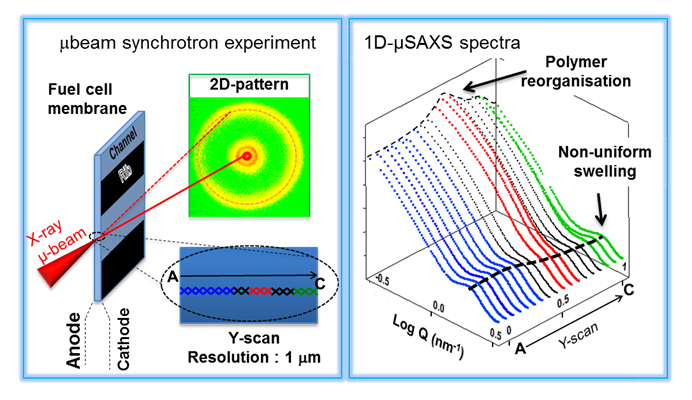The physical ageing of fuel cell polymer membranes is a major cause of system failure: cracks and holes are often observed post-mortem. We have designed a scattering experiment as a unique non-intrusive ageing diagnosis tool in order to get insights into the degradation process and, consequently, provide efficient guidelines for increasing the system life-time. The availability of intense, micro-sized X-rays beams produced by the world-class high brilliance synchrotron sources released the possibility to perform spatially-resolved 3D mapping of complex nanostructures. mSAXS spectra of a fuel cell membrane aged for 2500 hours were recorded both in-plane and out-plane, in the various regions of interest: anode/cathode side, gas inlet/outlet, under channels (distributing gas) and ribs (collecting current). The nature, localization and degree of physical degradation were quantitatively obtained.
We found that the aged membrane structure is highly heterogeneous with respect to pristine membrane. The long-term exposure to water at elevated temperature was found to produce a systematic degradation due to membrane overswelling. Additionally, a non-uniform anode-to-cathode swelling behavior at nanoscale and significant large-scale polymer reorganizations were reported in some regions (for instance, under the channels close to gas inlets). Ageing is in that case associated to the presence of important water gradient concentrations from anode to cathode. The spatially-resolved microscopic diagnosis of the membrane’s states was correlated to the specific cell design and operating conditions, providing therefore unique inputs for advanced system modeling and fuel cell optimization.
This work was funded by the NTE program (DIGEST project) and involved a tight collaboration between INAC and LITEN.
The experiments were performed on the ID13 beamline at the ESRF in Grenoble.
 Synchrotron microSAXS experiment on aged membranes : 2D patterns recorded across membrane thickness (Y-scans) with submicrometer resolution. Typical Y-scans spectra from anode to cathode-side: evidence of heterogeneous nanoswelling and large-scale polymer reorganization due to physical degradation of the membrane after 2500 hours in fuel cell stack.
Synchrotron microSAXS experiment on aged membranes : 2D patterns recorded across membrane thickness (Y-scans) with submicrometer resolution. Typical Y-scans spectra from anode to cathode-side: evidence of heterogeneous nanoswelling and large-scale polymer reorganization due to physical degradation of the membrane after 2500 hours in fuel cell stack.